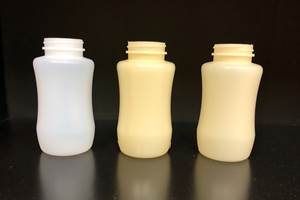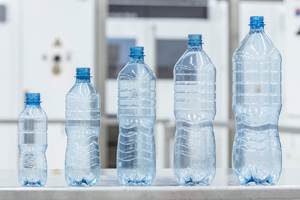SPE Automotive Division's 2018 Hall of Fame Winner
The 2003 Honda Element compact SUV featured the first injection molded thermoplastic (PC/PBT) rear energy absorber for a vehicle bumper system.
This was the fifth year in a row that I had the honor of participating as a judge in the esteemed SPE Automotive Division Blue Ribbon Automotive Innovation Awards Competition. I plan to report on the winners of the nine categories—including a new ‘additive manufacturing’ slot—as well as several of the other final nominees in the near future, following SPE’s 48th annual Automotive Innovation Awards Competition & Gala on Nov. 7, at the Burton Manor in Livonia, Michigan.
The organization has already named the 2018 Hall of Fame Award winner, which will be honored by celebrating the technology, companies, and people originally involved in its development. To be considered for a Hall of Fame Award, an automotive plastic or composite component must have been in continuous service in some form for at least 15 years and broadly adopted in the automotive industry. Given that criteria, this winner certainly qualifies. It was the first injection molded PC/PBT rear energy absorber for a vehicle bumper system, used on the 2003 Honda Element compact crossover SUV from Honda Motor Company.
Made with Xenoy PC/PBT resin from SABIC (then GE Plastics), the energy absorber replaced expanded polypropylene (EPP) foam energy absorbers in less package space at lower cost with better damageability performance. Since then, over 80 million pounds of Xenoy injection molded energy absorbers have been validated and launched on multiple vehicles, in both front and rear bumper system applications, leading to numerous innovations improving crash safety worldwide.
This energy absorber technology set the precedent for many other industry-first applications.The use of Xenoy was first recognized in the industry in 2004, when Ford Motor Company won the SPE Hall of Fame Award for the bumper on the 1984 Escort developed by Ford Milan (Visteon). The material was recognized again in 2005 when Suzuki Motor Corporation won an SPE Automotive Innovation Award in the safety category for the first pedestrian protection energy absorber on the 2005 Swift. Tekagi Seiko was the system and tooling supplier and material processor. In 2013, it was recognized for an SPE Automotive Innovation Award in the chassis category, as the first global one-piece front bumper energy absorber on the 2013 Fusion and Mondeo sedans produced by Ford Motor Company. Magna Exteriors & Interiors was the tier supplier/processor.
The technology has also been recognized as a finalist, two times, in the 2011 SPE Automotive Innovation Awards. Those finalists included use of Xenoy on he first lower leg protector/undertray with protection-safety functionality on the 2011 C-MAX from Ford Motor Company (Faurecia: system supplier and material processor); and the injection molded pedestrian-safety upper load path/fascia reinforcement on the 2011 Range Rover Evoque compact utility vehicle. Also in that year, the technology was recognized on another innovative nomination—crash boxes for truck cabin occupant protection on the 2011 India 7T LCV commercial truck produced by Volvo-Eicher Commercial Vehicle Pvt. Ltd. (Machino Plastics Ltd: system supplier and material processor).
Injection molded Xenoy energy absorber technology offers improved styling freedom and functional integration as 15 mm less packaging space is required, compared to EPP foam used previously. The resin energy absorber’s efficiency enables smaller offsets (approximately a 20-30% reduction at equal load) resulting in a 20% weight savings. The Honda Element rear energy absorber demonstrated the best performance results in 2003 Insurance Institute for Highway Safety (IIHS) testing. It also demonstrated the lowest rear bumper repair costs, with more than 50% lower costs in most applications; as well as the highest bumper rating in 5 MPH crash test results of large luxury cars and small and midsize SUVs.
Improved consistency over temperature ranges was also achieved (impact consistency from -30 C/F to 60C/140 F). In addition, better low-speed performance was gained with lower rail loads (approximately 20-30% reduction at equal intrusion), lower intrusion, and lower peak loads resulting in less damage to the beam and improved driver and passenger safety.
At November’s SPE Automotive Innovation Awards Gala, representatives from Honda R&D Americas, Net Shape (now part of Shape Corp.), Shape Corp., and SABIC will accept the award on behalf of the original team that worked to develop the first injection molded thermoplastic (PC/PBT) energy absorber for a vehicle bumper system on the 2003 Honda Element.
Related Content
How to Extrusion Blow Mold PHA/PLA Blends
You need to pay attention to the inherent characteristics of biopolymers PHA/PLA materials when setting process parameters to realize better and more consistent outcomes.
Read MoreFor Extrusion and Injection-Blow Molders, Numerous Upgrades in Machines and Services
Uniloy is revising its machinery lines across the board and strengthening after-sales services in tooling maintenance, spare parts and tech service.
Read MoreWhat to Look for in High-Speed Automation for Pipette Production
Automation is a must-have for molders of pipettes. Make sure your supplier provides assurances of throughput and output, manpower utilization, floor space consumption and payback period.
Read MoreFirst Water Bottles With Ultrathin Glass Coating
Long used for sensitive juices and carbonated soft drinks, KHS Freshsafe PET Plasmax vapor-deposited glass coating is now providing freshness and flavor protection for PET mineral water bottles.
Read MoreRead Next
Making the Circular Economy a Reality
Driven by brand owner demands and new worldwide legislation, the entire supply chain is working toward the shift to circularity, with some evidence the circular economy has already begun.
Read MoreFor PLASTICS' CEO Seaholm, NPE to Shine Light on Sustainability Successes
With advocacy, communication and sustainability as three main pillars, Seaholm leads a trade association to NPE that ‘is more active today than we have ever been.’
Read MoreLead the Conversation, Change the Conversation
Coverage of single-use plastics can be both misleading and demoralizing. Here are 10 tips for changing the perception of the plastics industry at your company and in your community.
Read More














